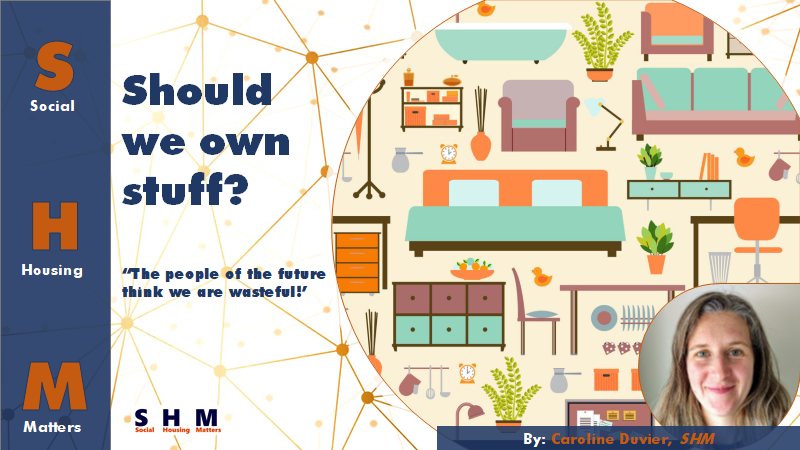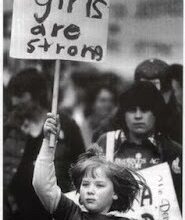
Take a look around the room you are in right now, if you are at home. How many of the things you see do you own? All of them? Most of them? How quickly do you run out of fingers to count the things you own? Each of us, depending on income and ability, own several hundred different things. Think small, such as phones, shoes, or mugs. Then think big, such as beds, sofas, and TVs. The question I want to ask in this article is: do we need to own all this stuff? And what happens when we stop thinking about ownership, and start thinking about leasing, renting, or simply using what is already there?
The people of the future think we are wasteful
Let me give you an example: I started reading a climate change thriller set in the future (Der neunte Arm des Oktopus, Dirk Rossmann). People in the year 2100 are appalled that we today, in the year 2021, own things in our houses. In the future, everything is already supplied – the bed, the kitchen with all the utensils you would need, everything. People of the future are appalled at the idea of ownership because it is wasteful. For every household, a new bed, new sofa, new TV, new mugs, new plates, new carpets need to be manufactured and shipped. When people move, they might get rid of their old sofa and buy a new one. The amount of material waste this creates is massive, and we already have a humongous issue with waste as it is. Landfills are overflowing, the ocean is full of plastic, people in the Global South die when they burn waste being shipped over from the Global North. The materials we use are mostly unsustainable – plastics, cheap wood, colourants with dangerous chemicals inside.
This, however, is the way we have lived for a few decades now. We might have passed furniture down through the generations, got the clothes from our older siblings, and used our grandparent’s cutlery and plates until they had too many cracks in them. Now we want our own style, supplied cheaply through the myriad of shops out there that promise us bolder colours, shapes, and personalities. We are entirely removed from the process of how these goods are created, and where they go once we are through with them. If you recognise yourself here, then you are lucky enough to afford to buy new things as and when you think you need them. What happens to people who cannot afford to buy stuff? This is where I think the idea of using what is out there comes into play.
Using what is already there
What do I mean by that? Imagine you are looking for a place to rent from a social landlord. You have three kids, your partner died, and your part-time work does not earn you enough to afford the place you currently rent on the private market. All your possessions have already been taken because you did not pay your last three months’ rent, or utilities. You go on a few viewings with different social landlords. Most of the places you see have been stripped bare. No carpets, no white goods like a fridge or washing machine. The only things you would NOT need to buy are the sinks, the toilet, and the bathtub. You make a mental note of how much money you would need to afford just the basics, like beds. Looks like you might have to sleep on the floor for a long time.
You have your last viewing scheduled with a new landlord on the block. As the housing officer opens the door to the flat, you are a bit confused. Didn’t they say this place was currently unoccupied? Then why is it full of furniture? You ask the housing officer. What they say astonishes you. This landlord paired up with design companies, universities, and research labs to create fully furnished adaptable properties where all you need to bring is your clothes. Your rent is not going to be higher because of the furniture. Why not, you ask? The housing officer smiles. They say they want to offer homes, not just properties. You look around. The furniture looks simple and sleek. The housing officer lets you try out the adaptability of the furniture. The kitchen table can be folded up against the wall to create more space. A simple button press releases another cutting surface next to the hob. The beds can be folded up to create more floor space without using physical strength. You could see yourself living here until you are 90, it is so easy to move each piece in the home. The housing officer explains that everything inside the home has been designed with their current customers in workshops, from the youngest to the eldest. The pieces created reflect what people wanted and needed in their homes, and they are now part of every single property they offer.
Why this could be interesting to social housing providers
We can go further with this thought experiment. We could imagine the jobs that are created with this kind of provision model, even offering employment and apprenticeship schemes to residents. We could imagine interested investors who are looking for organisations with good ESG (environment, social, governance) performance. Tenancies might be sustained, and depending on how much commitment is created and continued, whole communities could be built. We could envisage how the furniture created for the social housing sector might be turned into a lease or rent model for the private sector – homeowners could lease furniture, and when it breaks or they want to replace it, they take out a new lease, returning the old furniture to the manufacturers for sustainable repurposing or demolishing.
At SHM we featured plenty of organisations that might play a role in a future such as this; think of End Furniture Poverty or Invisible Creations. Organisations such as these could partner up with universities such as the one that employs me, creating a web of connections that is working towards the same goal. As Dirk Gently would say: Don’t you see? Everything is interconnected. Just as with climate change and its mitigation – we know what we need to do, we have all the tools. All we need to do is start and be willing to accept that we might have to change our mindset. If you think about everything that you own: how attached are you to any of it? If you are attached to any of your stuff, do you need to be? What if you become so attached to stuff that you end up like Gollum?
In a world full of immediate distractions and gratifications, it is easy to become complacent. This is what I would have said before the Coronavirus pandemic. The pandemic’s horrific onslaught offered us a glimpse of a future in which we destroy our natural habitats to the extent that we create new diseases and bring back ancient ones buried in the permafrost. The pandemic highlighted extreme inequality globally – starting with billionaires like Jeff Bezos making many more billions out of the pandemic, to nurses being refused a pay rise, small business collapsing without much government help, ethnic minority groups being unfairly affected by the virus due to existing structural racism perpetuating inequality, and now, with countries in the Global South not knowing when they might be able to vaccinate their populations because countries in the Global North deny equal access but are very happy to reap the ongoing benefits from colonialism for which they still do not apologise or even try amend they damage they have done.
Let us do the people of the future a favour. Let us consider them in our decision-making. Let us try and think outside the box, try and imagine how things could be different. It seems to me that we are so lost in our everyday struggles that we fail to see what it is we are living for. Is humanity supposed to be filling its days with cute cat videos surrounded by things made of plastic and food that isn’t even nutritious anymore? It’s a far stretch, yes, but it is supposed to illustrate that if we think big, creating social housing tenancies where landlords provide functional furniture is not so difficult to imagine. And if we can imagine it, we can do it.



